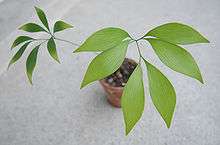Bowenia
The genus Bowenia includes two living and two fossil species of cycads in the family Stangeriaceae, sometimes placed in their own family Boweniaceae.[1] They are entirely restricted to Australia. The two living species occur in Queensland. B. spectabilis grows in warm, wet, tropical rainforests, on protected slopes and near streams, primarily in the lowlands of the Wet Tropics Bioregion. However, it has a local form with serrate pinna margins that grows in rainforest, Acacia-dominated transition forest, and also Casuarina-dominated sclerophyll forest on the Atherton Tableland, where it is subject to periodic bushfire. B. serrulata grows in sclerophyll forest and transition forest close to the Tropic of Capricorn.[2][3][4]
| Bowenia | |
|---|---|
 | |
| Scientific classification | |
| Kingdom: | Plantae |
| Clade: | Tracheophytes |
| Division: | Cycadophyta |
| Class: | Cycadopsida |
| Order: | Cycadales |
| Family: | Stangeriaceae |
| Subfamily: | Bowenioideae Pilger |
| Genus: | Bowenia Hook. ex Hook.f. |
| Species | |
|
† Bowenia eocenica | |
Species
| Image | Scientific name | Distribution |
|---|---|---|
| Bowenia serrulata Chamb. | Queensland | |
| Bowenia spectabilis Hook | Queensland |
The fossil species Bowenia eocenica is known from deposits in a coal mine in Victoria, Australia, and B. papillosa is known from deposits in New South Wales. Both fossils are of Eocene age, and consist of leaflet fragments.[5]
References
- Stevenson, Dennis William. 1981. American Journal of Botany 68: 1114
- Kew World Checklist of Selected Plant Families
- Hill, K.D. & Stevenson, D.W. (1999). A world list of Cycads, 1999. Excelsa 19: 67–72.
- Christenhusz, M. J. M., J. L. Reveal, A. K. Farjon, M. F. Gardner, R. R. Mill & M. W. Chase. 2011. A new classification and linear sequence of extant gymnosperms. Phytotaxa 19: 55–70.
- Hill, R.S. 1978. Two new species of Bowenia Hook, ex Hook, f. from the Eocene of eastern Australia. Australian Journal of Botany 26(6) 837–846.